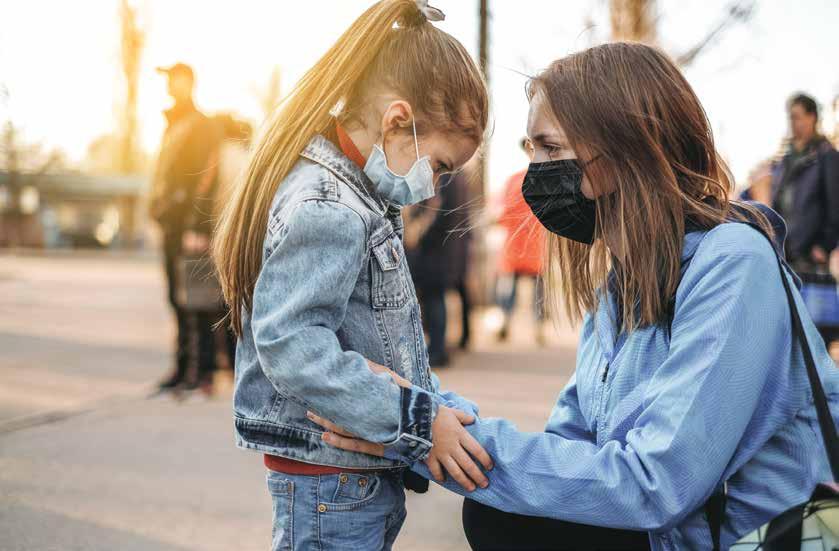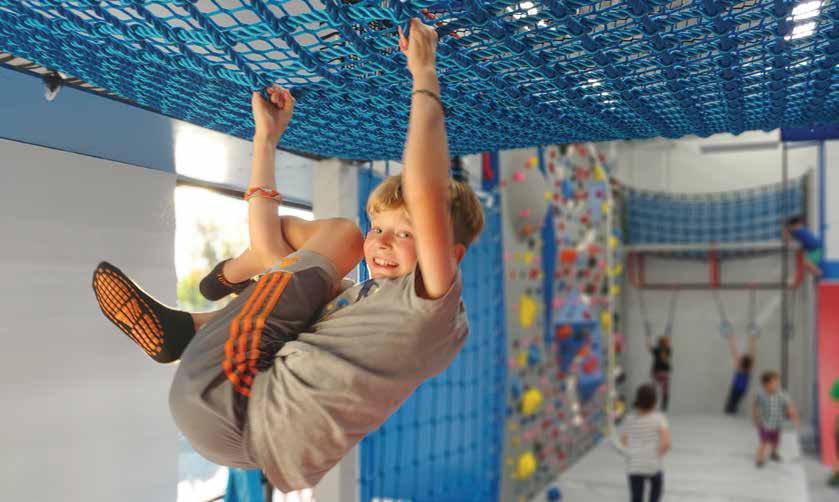
9 minute read
EDUCATION
Advertisement
Lora Nordquist is the Bend-La Pine Schools’ interim superintendent for the 2020-2021 school year. The BLPS board voted to promote her to the position for one year and put the search to find a new superintendent on hold during the pandemic. Photo by Laurel Brauns
Pandemic School Year 2020-2021 may be the weirdest school year in Central Oregon since 1918. By Laurel Brauns
This fall, only the youngest students in the Bend-La Pine Schools district will go back to their brick-and-mortar classrooms, but COVID prevention protocols will begin the minute they step on the school bus. Most local students will not come to campus at all. At least, that’s the latest word as of this writing; most who follow the issue know things can—and have—changed many times.
On July 28, Gov. Kate Brown announced a set of new rules and metrics that Oregon school districts must follow to offer in-person instruction. The announcement made BLPS’ previous pandemic plans obsolete overnight.
In order to reopen school buildings to students, Brown’s metrics require that counties must have 10 or fewer COVID-19 cases per 100,000 residents during the previous three weeks. Deschutes County had 54.6 cases per 100,000 for the week ending July 25.
Another school requirement is that for every person who takes a coronavirus test in the county, only 5% or less of those tests may come back positive in a seven day period. The same applies at the state level. Over the last weeks in July, the statewide positive test rate was 5.9%, 5.4% and 5.1%, according to the Oregon Health Authority. In Deschutes County, the positive test rate was 3.4%, 7.5% and 4.6%.
The rules are less strict for students in kindergarten through third grade, so as of press time, BLPS aims to offer a hybrid in-person / online program for these students, according to Lora Nordquist, Bend-La Pine Schools interim superintendent.
“We believe that our youngest students learn best in three dimensions, with ongoing adult support as they learn not only academic subjects, but basic social-emotional skills that are best learned in person,” Nordquist wrote in a statement to parents.
For younger students and staff that do come to school, everyone in the building will wear masks, except those with medical exceptions. Students will stay 6 feet apart and no more sharing crayons. In some cases, office staff might set up plastic barriers at their desks or just wear large, clear face shields throughout the day.
The state’s blueprint for opening schools
In June, the Oregon Department of Education—in partnership with Gov. Kate Brown and the Oregon Health Authority—released a 47-page book of guidelines for the 2020-2021 school year, to help schools create their own “blueprint” for reopening. As the guidelines were updated throughout the summer, BLPS continued to adjust. Its final plans will need to be passed by the BLPS board, then reviewed by Deschutes County Health Services and finally sent to ODE.
The Jefferson County and Culver School districts were, as of late July, planning for both in-person and distance learning scenarios. Brown’s orders make some exceptions for rural school districts, and Culver is one of the smallest in the state with only 675 students.
Before Brown’s July 28 announcement, the BLPS district planned to have all middle and high school students in come in for classroom instruction at least a few days a week.
Going Online
Under July 28 guidance, students in grades 4 through 12 will adhere to a structured online program from home where they’ll have daily contact with their teachers, regular feedback and graded assignments.
With parents, teachers and students all on the same online learning platform (Canvas for middle and high school, Google Classroom for elementary), it will be a different experience than Spring 2020, Nordquist said. Teachers will get extra training in online instruction this summer and they’ll put all students assignments in one place, which will keep everyone on track, she said.
The BLPS district has more than a decade of experience with online education. In 2006, it began offering Bend-La Pine Online for K-12 students. During the 2018-2019 school year, the program served more than 4,000 students, with 700 who received the bulk of their instruction online only. This program is still an option, but most students will likely stay enrolled in the school’s primary learning program this year where they will stay engaged with the district’s standard curricula.
“Remote learning keeps kids connected to their local school, teachers and classroom community,” the district’s website states. “When in a remote learning setting, students will be engaged in activities and projects directly related to their in-class instruction and course outcomes.”
Nordquist said the pandemic has presented some great opportunities, particularly for asynchronistic learning, or participating in class activities at different times then other students.
“This spring many teachers made videos of individual lessons,” she said. “Now a student who might be too shy to ask a question in class, they can access that video [and learn at their own pace]. Also some teachers provided a variety of assignment options online to increase engagement. This is something that could be great all the time.”
82 PARKS 80+ MILES OF TRAILS
find your space for play.

Everyone needs to play. It’s okay, you can with a few rules. Distancing is a must when you visit a Bend Park & Recreation District park, trail, recreation center and even the river. • Stay six feet from others, indoors and out. If you can’t, wear a face covering. • Visit less popular parks and trails or at less busy times. • Go only with your household or in a small group. • Wash your hands before and after a visit. • Follow local and national health guidance. • If you’re sick, stay home.
For more on distancing done right and playing it safe, visit bendparksandrec.org.
One Step Ahead
Anticipating the school year and the pandemic’s impact on kids’ mental health
By Annette Benedetti
Even before 2020 took the U.S. by storm with COVID-19, anxiety and depression were prevalent among our youth. Now more than ever, with the new school year quickly approaching, parents are faced with the challenge of figuring out how to not only calm their children’s fears of becoming and getting others sick, they have to quell their feelings of loss and isolation now that home and online schooling have become the new norm.
This fall, families might expect their young students to attend online classes where they won’t be able to touch their friends or teachers, and will only interact digitally from home. The limited interaction they have with other children and adults will entail wearing masks. The question is, what can be done to alleviate the stress, fear and sadness that is sure to result from this new way of life?
Shanti O’Connor is a licensed counselor and founder of The Hive in Bend. Her extensive work with mothers in all phases of their parenting journey has given her unique insight into parenting practices that help support both parents and children through difficult times. She offers up some thoughts and suggestions for parents on how to help support their kids’ mental health as they prepare to head back to and make their way through the new school year for which there is still so much uncertainty.

Tips for Supporting Children If and When They Head Back to School
O’Connor suggests the following: 1. Leading into the end of August and the beginning of September, establish a solid routine that mimics a school schedule. 2. As school starts to near, take the time to talk with your kid(s) about what to expect…what their school day will be like, and how these changes are being implemented. Be age specific and direct. Don’t dumb down the conversation, but also don’t try to scare your child. Use facts and help your child empathize with the situation. 3. The night before school starts, check in with your child. Validate any fears they express, and try if to help them reframe their fears to a more positive outlook. 4. For the first few months, keep your family schedule simple and consistent…This will give your child a feeling of safety and security in a time of uncertainty. It will also allow your child space to experience and express whatever feelings and emotions that may arise from school.
Helping the Overwhelmed Child
She offers the following tips that parents can use to help their children between the ages of 2 to 18 process feelings.
Don’t grill your child...Tune in to their mood and what they seem to need. It may be that your child looks happy and is ready to share... It’s also possible your child is tired and overwhelmed and needs some time to relax and process the day. Give your child space and let them lead. If you want to ask a question, be specific…Show them that you are curious, but do not be invasive.
Do art with your child. Put on some calming music, let your child pick the medium of art they want to use, and let them have the space to talk or not talk. The intention is to be present with your child and to allow that presence to help them feel safe.
Once you are done, share what you made then ask if they feel comfortable sharing what they made. Don’t interpret the drawing. Be curious and ask questions like, “Tell me about...what is it?”
— Shanti O’Connor
Go for a nightly walk. The bilateral stimulation from walking helps us to organize our thoughts and process emotions. Walking on a trail together can lead to deep conversations. The fresh air, the trees, the animals, and the sun all help to down-regulate the nervous system and bring more coherence to the body. You’ll be amazed at how quickly your child will start to share stories and feelings.
O’Connor explains that the idea is to find ways to connect with your child. Other activities that help create connection and the opportunity for your child to share their fears are bike rides, board games, watching movies and reading books together.
A Word on How to Talk to Your Kids
When talking to your children, O’Connor suggests staying away from giving advice. “Instead, after your child shares, simply reflect back what he just said. In your own words give a condensed reflection on what you heard him say. If you are picking up certain feelings behind the words, then share that. For example: ‘It sounds like you are feeling nervous about talking to an adult wearing a mask.’ If you are picking up an overall meaning behind his share, then reflect that.” she explains.
O’Connor suggests that once you have some clarity, ask your child what they want to do to address the issue. “As a parent, we want to empower our children. We want them to know that we know they are capable of solving their problems and that they will have your support,” she explains. “Remember: The intention isn’t to change or fix, but to be a safe and loving presence. The more you can hold a position of neutrality the more effective you will be in helping your child process their feelings and empower them to make the changes they are ready to make.”
New Shops to Explore!
OPENING SUMMER LUSH ¬ SEPHORA SOMEWHERE THAT’S GREEN
Bend Happens Here






